LISA Pathfinder prepares for final exams
18 June 2015
The summer is coming and that means students across Europe are sitting their final tests. ESA's LISA Pathfinder, a technology demonstrator that will pave the way for space-based gravitational wave observatories, is no different. It is currently in the test centre at IABG (Industrieanlagen-Betriebsgesellschaft), Ottobrunn, Germany."Everything is running nominally and we are on schedule, which is the most important thing," says Ulrike Ragnit, AIV and launch campaign manager for LISA Pathfinder.
LISA Pathfinder is a rather special spacecraft. It is designed to measure how well we can isolate a macroscopic body from all external forces except gravity. If successful, it will open the door to a new breed of spacecraft that can observe the gravitational Universe. For astronomers, this will be as if they developed a new sense, providing access to a view of the Universe that is wholly different to what they can detect now via electromagnetic radiation.
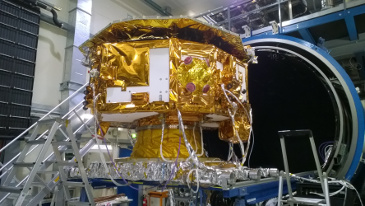 |
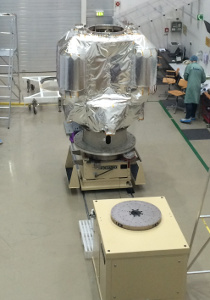 |
| The LISA Pathfinder science module (above) and the propulsion module (right) at the IABG test centre. Credit: (Above) ESA - J. Huesler; ESA - U. Ragnit |
The LISA Pathfinder spacecraft consists of a science module, which contains the core science experiment, and a separable propulsion module, which will transfer the science module to its operational orbit at L1, 1.5 million kilometres away from Earth in the direction of the Sun.
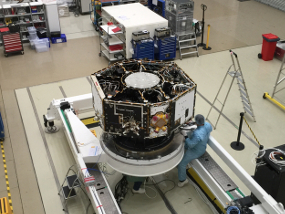 |
|
| LISA Pathfinder science module (left) and propulsion module (right) during testing. Credit: (Left) ESA – P. McNamara; (Right) IABG |
|
Since arriving at IABG in March, the two modules have been tested — most of the time separately. This has allowed engineers to run individual activities in parallel, increasing the efficiency and improving the schedule. These tests have confirmed that all the spacecraft's systems are working as expected. In addition, a fit-check has been performed with the launch vehicle adapter, which is used to attach the spacecraft on the Vega launcher.
The Ottobrunn centre of IABG, where these tests are being carried out, is located on Einsteinstraße, which is highly appropriate since LISA Pathfinder will investigate Einstein's theory of gravity: that bodies free of external forces follow paths called geodesics in spacetime. To do this, it will use a pair of inert metal cubes. Each of these 46 mm cubes — slightly smaller than a standard Rubik cube — weighs 1.96 kg, and has been hewn from an ingot of gold-platinum alloy. They will float freely inside the spacecraft, moving only under the effect of gravity. This movement will be measured to an accuracy of 100,000th of the width of a human hair using laser beams.
This science experiment is known as the LISA Technology Package (LTP). As well as the inert metal cubes, there is also a 20cm by 20cm block of Zerodur ceramic glass with 22 mirrors and beam splitters. This is the heart of the LTP because it is the laser measuring device.
The LTP has been integrated into the science module in recent weeks. Next, the science module and propulsion module will be joined to form the 'Launch Composite', so called because this is the configuration in which they will be when launched.
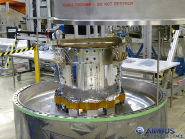 |
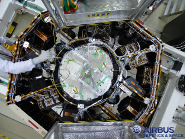 |
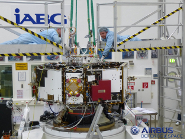 |
| Integration of the LISA Technology Package Core Assembly. Credit: Airbus Defence and Space 2015 | ||
With the Launch Composite complete it will be time to begin the final tests. These include the acoustic test, which is carried out to make sure the modules can survive the intense noise generated by the launcher rocket engines in the first few seconds after ignition.
The final activity prior to shipment to the launch site will be the 'mass property measurement' of the Launch Composite. The entire spacecraft will be precisely weighed to determine its mass, the centre of gravity, and the moments of inertia, which will be used to calculate the flight trajectory.
Normally it is the thermal control of the spacecraft that takes precedence when the layout is designed, so units that have the same thermal behaviour are grouped together. In LISA Pathfinder, however, the most important aspect is to distribute the mass evenly around the craft. Anything added or taken away must be accounted for, even down to the ends of cable-ties that are cut off to tidy up the spacecraft.
"We always log every mass on a spacecraft but usually not with this detail," says Ragnit.
The data are used to create a digital 'gravitational model' of the spacecraft. This model is used to add strategically located 'balance masses' to ensure that the gravity produced by the spacecraft acts on both of the gold-platinum cubes equally. This suppresses the effect of the spacecraft's own gravitational field on the science measurement.
"Readying this spacecraft for launch requires an intense schedule, but an achievable one thanks to the dedication of the spacecraft team," says Ragnit. "All this hard work is paying off. At this stage, the spacecraft is on course to be ready for shipping to the launch site after the Summer."
Launch of LISA Pathfinder is scheduled for late 2015 on a Vega rocket from Europe's spaceport at Kourou, French Guiana.
About LISA Pathfinder
LISA Pathfinder is a European Space Agency mission to test the technology required to detect gravitational waves in the range of 0.1mHz to 1Hz. The mission will demonstrate critical technologies for future gravitational wave observatories, in a space environment. These technologies include: inertial sensing, drag-free attitude control, and interferometry with free-falling mirrors.
An industrial team led by the prime contractor, Airbus Defence and Space - Stevenage, is building LISA Pathfinder. Airbus Defence and Space – Friedrichshafen is the payload architect for the LISA Technology Package (LTP).







